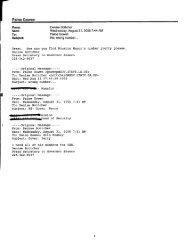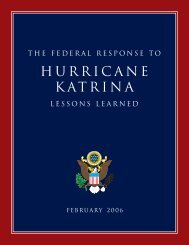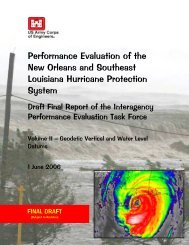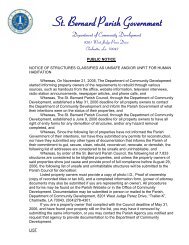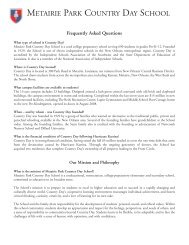IPET Report 3 Vol VIII
IPET Report 3 Vol VIII
IPET Report 3 Vol VIII
Create successful ePaper yourself
Turn your PDF publications into a flip-book with our unique Google optimized e-Paper software.
Bister and Emanuel 2002; Free et al. 2004; Chan and Liu 2004). This is in agreement with findings<br />
based on global circulation models. For example, Knutson and Tuleya (2004) and Michaels<br />
et al. (2005) predict increases in wind speed of 5% or less by the year 2080. Therefore, while<br />
future variations in intensity due to global warming are considered possible, it is generally<br />
expected that such variations was modest and overshadowed by the multi-decadal fluctuations.<br />
Results that contrast with this general consensus are reported in Emanuel (2005a). Using data<br />
worldwide, Emanuel found that the energy released by hurricanes has increased by about 70%<br />
over the past 30 years and attributes the phenomenon to global warming. This phenomenon is<br />
contributed by an increase of 15% in the maximum wind speed and an increase of 60% in storm<br />
duration. These findings have been contested by other researchers and must be considered preliminary<br />
pending further validation.<br />
Epistemic Uncertainty on Future Hurricane Climate. From the preceding discussion,<br />
uncertainty on the hurricane statistics in the Gulf of Mexico during the next 50-100 years is<br />
dominated by multi-decadal oscillations. Specifically, considering that the North Atlantic is now<br />
experiencing a 50% higher-than normal activity and that this elevated activity may persist over a<br />
number of years and possibly decades, it is reasonable for the next 50-100 years to increase the<br />
average historical rate of hurricanes by 20% and allow for an additional 25% uncertainty factor<br />
around this corrected rate. The latter factor includes uncertainty on the historical rate due to the<br />
finite observation period (16%) as well as uncertainty on the future evolution of the hurricane<br />
frequency (judgmentally assessed).<br />
Considering the general consensus and dissenting views on the effect of global warming on<br />
hurricane intensity, the historical mean pressure deficit is increased by 3% and an uncertainty<br />
factor of 5% is applied to the increased mean value. Since the effects of different factors on<br />
hurricane frequency and intensity are poorly correlated, these components of epistemic<br />
uncertainty may be treated as independent.<br />
Hurricane Waves<br />
Introduction. An approximate method has been used for calculating waves and wave setup<br />
due to hurricane winds over the Gulf of Mexico. The quantification of deep water waves is based<br />
on a method published in the Shore Protection Manual 1 (1984). The wave setup is based on the<br />
physics governing wave setup, considers an average slope over the profile and employs the Dally<br />
et al (1985) wave breaking relationship over the full range from deep to shallow water. The<br />
method is described in detail in Appendix 8.<br />
The Shore Protection Manual (SPM) provided recommendations for calculating deep water<br />
wave characteristics in a hurricane. These methods included two equations, one for the maximum<br />
significant wave height and one for the associated wave period. In addition a graph was<br />
provided which represented the non-dimensional distribution of wave heights in a hurricane.<br />
1 The predecessor to the Coastal Engineering Manual of the U.S. Army Corps of Engineers.<br />
<strong>Vol</strong>ume <strong>VIII</strong> Engineering and Operational Risk and Reliability Analysis <strong>VIII</strong>-39<br />
This is a preliminary report subject to revision; it does not contain final conclusions of the United States Army Corps of Engineers.



